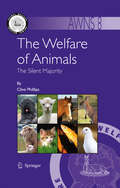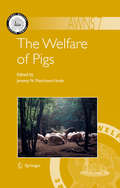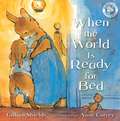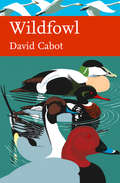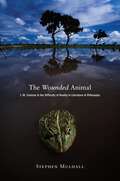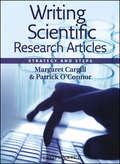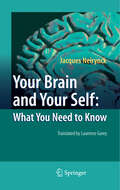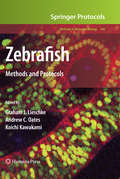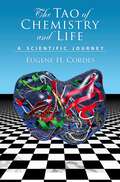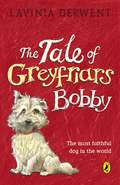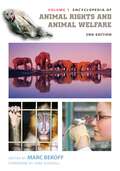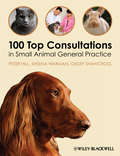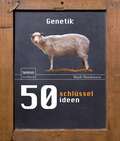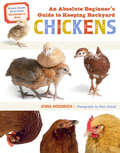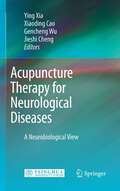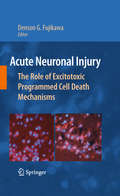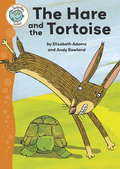- Table View
- List View
The Welfare of Animals: The Silent Majority (Animal Welfare #8)
by Clive PhillipsThe Welfare of Animals is an exciting book that will stimulate and provoke its readers. It describes many problems faced by animals – those we use for food, for pleasure or in research, and those simply but harshly affected by shrinking habitats in the face of the ever-growing human population. And yet it is not a depressing read. It focuses not only on the difficulties that animals face, but on their capacity for free-choice, for joy and excitement, and on the possible ways in which the planet can be shared between species if only we take the time and trouble to think more carefully about the impact of our actions. Clive Phillips moved from the United Kingdom to take up a Foundation Chair in Animal Welfare at the University of Queensland, becoming Australia’s first Professor of Animal Welfare in 2003. This cultural leap, combined with his travels in countries like Malaysia and Borneo, permits him the unique and broad perspective that forms the backbone of this book. Eschewing the normal territory patrolled by the animal scientist (explaining the physiological basis of the stress response or causation of abnormal behaviour), Clive ventures into jungles and deserts, city centres and tribal homelands, and presents a book that remarkably and successfully combines travel-diary, nature notes, social and cultural history.
The Welfare of Pigs (Animal Welfare #7)
by Jeremy N. Marchant-FordeThe domestic pig is perceived as an animal with intelligence and character and yet, in the industrialized world, the majority of people have had little or no contact with them. Pigs are subject to a wide range of environments from the tropics to the sub-arctic, ranging from small-scale, extensive systems to large-scale intensive systems. They may spend their whole life on one farm or may be subject to long-distance transport multiple times. Not surprisingly, many aspects of their life experiences can impact their welfare. This book brings together a team of leading pig welfare research scientists to review the natural history of the pig, the welfare of pigs at different stages of life and to indicate what the future holds in terms of pig welfare. The text is aimed at researchers and teachers working in veterinary and animal science together with those working in the pig industry and for governmental and non-governmental animal welfare organizations.
When the World Is Ready for Bed
by Gillian ShieldsA family of rabbits go through their end-of-day routine, from having their tea to brushing their teeth, sharing a story and being tucked up in bed, until they peek out of the window and see something that's a change from their usual routine in this classic picture book.With delectable art and warm, lyrical text, this is a thoroughly modern picture book with strong echoes of books such as The Velveteen Rabbit and the works of Beatrix Potter.
While Flocks Last
by Charlie ElderArmed with a field guide and a half-decent pair of binoculars, Charlie Elder travels the length and breadth of the British Isles to spot forty bird species in serious decline - the UK's Red List. He looks at why their numbers have fallen, what efforts are being made to encourage their recoveries and meets experts and enthusiasts who are working to make a difference. He also examines just why birds matter in the first place and considers the role of the birdwatcher - one species that is certainly not in decline.
Wildfowl (Collins New Naturalist Library #110)
by David CabotNew Naturalist Wildfowl provides a much-anticipated overview of the fascinating birds that have become icons of our diminishing wilderness areas.
The Wounded Animal: J. M. Coetzee and the Difficulty of Reality in Literature and Philosophy
by Stephen MulhallIn 1997, the Nobel Prize-winning novelist J. M. Coetzee, invited to Princeton University to lecture on the moral status of animals, read a work of fiction about an eminent novelist, Elizabeth Costello, invited to lecture on the moral status of animals at an American college. Coetzee's lectures were published in 1999 as The Lives of Animals, and reappeared in 2003 as part of his novel Elizabeth Costello; and both lectures and novel have attracted the critical attention of a number of influential philosophers--including Peter Singer, Cora Diamond, Stanley Cavell, and John McDowell. In The Wounded Animal, Stephen Mulhall closely examines Coetzee's writings about Costello, and the ways in which philosophers have responded to them, focusing in particular on their powerful presentation of both literature and philosophy as seeking, and failing, to represent reality--in part because of reality's resistance to such projects of understanding, but also because of philosophy's unwillingness to learn from literature how best to acknowledge that resistance. In so doing, Mulhall is led to consider the relations among reason, language, and the imagination, as well as more specific ethical issues concerning the moral status of animals, the meaning of mortality, the nature of evil, and the demands of religion. The ancient quarrel between philosophy and literature here displays undiminished vigor and renewed significance.
The Wounded Animal: J. M. Coetzee and the Difficulty of Reality in Literature and Philosophy
by Stephen MulhallIn 1997, the Nobel Prize-winning novelist J. M. Coetzee, invited to Princeton University to lecture on the moral status of animals, read a work of fiction about an eminent novelist, Elizabeth Costello, invited to lecture on the moral status of animals at an American college. Coetzee's lectures were published in 1999 as The Lives of Animals, and reappeared in 2003 as part of his novel Elizabeth Costello; and both lectures and novel have attracted the critical attention of a number of influential philosophers--including Peter Singer, Cora Diamond, Stanley Cavell, and John McDowell. In The Wounded Animal, Stephen Mulhall closely examines Coetzee's writings about Costello, and the ways in which philosophers have responded to them, focusing in particular on their powerful presentation of both literature and philosophy as seeking, and failing, to represent reality--in part because of reality's resistance to such projects of understanding, but also because of philosophy's unwillingness to learn from literature how best to acknowledge that resistance. In so doing, Mulhall is led to consider the relations among reason, language, and the imagination, as well as more specific ethical issues concerning the moral status of animals, the meaning of mortality, the nature of evil, and the demands of religion. The ancient quarrel between philosophy and literature here displays undiminished vigor and renewed significance.
WOW! Said the Owl: A First Book of Colours
by Tim HopgoodAt night, when we are feeling tired and ready for bed, owls are just waking up. But this curious little owl decides to stay awake all day, instead of all night, and discovers a world bursting with colour! But when the night-time comes around again, the stars above her head are still the most beautiful sight of all.WOW! Said the Owl is an engaging book about colours from Tim Hopgood, the winner of the Best Emerging Illustrator, Booktrust Early Years Award.
Writing Scientific Research Articles: Strategy and Steps
by Margaret Cargill Patrick O'Connor"Margaret Cargill's background as a linguist and research communications educator and Patrick O'Connor's experience as both research scientist and educator synergize to improve both the science and art of scientific writing. If the authors' goal is to give scientists the tools to write and publish compelling, well documented, clear narratives that convey their work honestly and in proper context, they have succeeded admirably." Veterinary Pathology, July 2009 "[The book is] clearly written, has a logical step-by-step structure, is easy to read and contains a lot of sensible advice about how to get scientific work published in international journals. The book is a most useful addition to the literature covering scientific writing." Aquaculture International, April 2009 Writing Scientific Research Articles: Strategy and Steps guides authors in how to write, as well as what to write, to improve their chances of having their articles accepted for publication in international, peer reviewed journals. The book is designed for scientists who use English as a first or an additional language; for research students and those who teach them paper writing skills; and for early-career researchers wanting to hone their skills as authors and mentors. It provides clear processes for selecting target journals and writing each section of a manuscript, starting with the results. The stepwise learning process uses practical exercises to develop writing and data presentation skills through analysis of well-written example papers. Strategies are presented for responding to referee comments, as well as ideas for developing discipline-specific English language skills for manuscript writing. The book is designed for use by individuals or in a class setting. Visit the companion site at www.writeresearch.com.au for more information.
Writing Scientific Research Articles: Strategy and Steps
by Margaret Cargill Patrick O'Connor"Margaret Cargill's background as a linguist and research communications educator and Patrick O'Connor's experience as both research scientist and educator synergize to improve both the science and art of scientific writing. If the authors' goal is to give scientists the tools to write and publish compelling, well documented, clear narratives that convey their work honestly and in proper context, they have succeeded admirably." Veterinary Pathology, July 2009 "[The book is] clearly written, has a logical step-by-step structure, is easy to read and contains a lot of sensible advice about how to get scientific work published in international journals. The book is a most useful addition to the literature covering scientific writing." Aquaculture International, April 2009 Writing Scientific Research Articles: Strategy and Steps guides authors in how to write, as well as what to write, to improve their chances of having their articles accepted for publication in international, peer reviewed journals. The book is designed for scientists who use English as a first or an additional language; for research students and those who teach them paper writing skills; and for early-career researchers wanting to hone their skills as authors and mentors. It provides clear processes for selecting target journals and writing each section of a manuscript, starting with the results. The stepwise learning process uses practical exercises to develop writing and data presentation skills through analysis of well-written example papers. Strategies are presented for responding to referee comments, as well as ideas for developing discipline-specific English language skills for manuscript writing. The book is designed for use by individuals or in a class setting. Visit the companion site at www.writeresearch.com.au for more information.
Your Brain and Your Self: What You Need to Know
by Jacques NeirynckHow does my brain work? Why am I conscious? Where is my memory? Is what I perceive around me reality or just an illusion? We all ask these questions, which we could sum up in a single question: Who am I? How is it that I have memories and that I feel I exist? What does it mean that my mind is free in time and space, and yet I am imprisoned in a body that is doomed to disappear? What happens to my mind when my body disappears? What are the risks of my suffering from a brain disease? Could my whole being eclipse because of a disease in which my body survives but my mind ceases to exist? What remedies are there? What hope does reasearch hold out? Recent discoveries about the brain allow us to ask such questions more pointedly, hoping to define more clearly the relations of the brain with the mind, of man with his body. This book is based on numerous discussions with specialists. It attempts to determine the state of the art. It is organized in chapters that can be read in continuity, but it is equally possible to discover the chapters in a different way.
Zebrafish: Methods and Protocols (Methods in Molecular Biology #546)
by Graham J. Lieschke, Andrew C. Oates and Koichi KawakamiIn the last 20 years, research activity using the zebrafish Danio rerio has increased dramatically, due in part to the ease of breeding and raising them, their genetic tractability, embryonic accessibility, and their imaging potential. In Zebrafish: Methods and Protocols, expert researchers provide a collection of experimental techniques for the genetic modification, manipulation, and in vivo live imaging of zebrafish. This volume collects sophisticated and practical techniques, including several not yet widely known, from laboratories around the world. Written in the highly successful Methods in Molecular Biology™ series format, chapters include brief introductions to their respective topics, lists of the necessary materials and reagents, step-by-step, readily reproducible laboratory protocols, and notes on troubleshooting and avoiding known pitfalls. Authoritative and accessible, Zebrafish: Methods and Protocols seeks to aid and inspire scientists utilizing this versatile animal model in their research.
Canine Sports & Games: Great Ways to Get Your Dog Fit and Have Fun Together!
by Kristin Mehus-RoeGet your dog off the leash and in on the game. Organized games are a wonderful way to bond with your pet while giving him the mental stimulation and physical exercise he needs. Kristin Mehus-Roe has games for all types of dog personalities and abilities, complete with rules, equipment lists, safety reminders, and much more. Teach your energetic pooch how to play flyball and your water-loving retriever to enjoy an afternoon of dock jumping. You and your dog have never had so much fun!
The Tao of Chemistry and Life: A Scientific Journey
by Eugene H. CordesWritten with the non-scientist in mind, this book employs the molecule and its interactions to explain the characteristics of living organisms in terms of the underlying chemistry of life. Following introductory chapters on the fundamentals of life, attention then turns to small molecules such as hormones and neurotransmitters and subsequently to macromolecules including proteins and nucleic acids. The interactions between small and macromolecules remains a central point throughout the book. These include enzymatic catalysis, hormone action, neurotransmission, regulation of metabolism, biosynthesis of macromolecules, the mechanism of action of drugs, taste, olfaction, learning and memory, and chemical communication. A second central point of emphasis is the sensitive relationship between chemical structure and biological activity. Examples abound and include why subtle changes in fatty acid architecture have positive or negative outcomes for human health in omega-three fatty acids and trans fats and how modest changes in the chemical decoration of the steroid skeleton provide the difference between male and female sex hormones. Beyond these examples taken from the chemistry of small molecules, the book includes a thoughtful consideration of genomics, including the relationship between genome structure and species. The theme of human health appears throughout the book. Cardiovascular medicine, cancer, metabolic diseases, and diseases of the nervous system receive significant attention including consideration of how a variety of drugs work in combating these issues. In sum, the goal of this book is to inform the non-scientist community in a way that will lead to increased understanding of the relationship between chemistry and life.
The Smartest Animals on the Planet: Extraordinary tales of the natural world's cleverest creatures
by Sally BoysenWe have all heard talk of the intelligence of dolphins, elephants orgreat apes, or even, in different ways, ants and bees. But what is thisintelligence all about? How do we know which animals are smart, and howdo they use this superior intelligence?Written by one of the world's authorities in this field, this rivetingbook cover the themes of tool use, language, communication, imitationand social learning, numerical abilities, social cognition, emotion,self-recognition and awareness, drawing together the most recent andremarkable global research relating to almost every "smart" species. Fully illustrated, and including step-by-step illustrations to showexperiments and observations both in the field and in captivity,Covering the core themes of, this book delivers cutting-edge scientificresearch about a topic fascinating to anyone interested in the naturalworld.
The Tale of Greyfriars Bobby
by Lavinia DerwentBobby, a lively little Skye Terrier, adores his master Auld Jock and when the old man dies, Bobby refuses to leave his grave in Greyfriars Churchyard in Edinburgh. By day, he plays with local orphans and eats at a nearby tavern, but every night for fourteen years Bobby returns faithfully to sleep by his master's grave.Based on a true story.
Encyclopedia of Animal Rights and Animal Welfare [2 volumes]: [2 volumes]
A landmark publishing achievement on the subject, the new edition of this acclaimed encyclopedia is expanded to two volumes, covering the full range of issues related to animal protection.Expanded to two volumes, the comprehensively updated new edition, Encyclopedia of Animal Rights and Animal Welfare: Second Edition is an extraordinary publishing event. It remains the only reference to cover the entire scope of animal rights and welfare from a global interdisciplinary perspective, with an international team of contributors assembled by Marc Bekoff covering animal treatment issues in the United States, China, India, Kenya, Australia, and many other nations. With a focused emphasis on fairness and justice for animals evident on every page, Encyclopedia of Animal Rights and Animal Welfare: Second Edition offers clear explanations of hot-button topics like puppy mills, endangered species in zoos, no-kill shelters, dog fighting, factory farming and disease, veganism, conservation ethics, wildlife contraception, and more. The encyclopedia also explores a range of religious, ethical, and philosophical views on using animals, as well as the latest research on animal cognition and sentience. The work helps readers understand the different viewpoints of animal welfare advocates who want to improve conditions for animals and animal rights activists who don't want animals used at all.
100 Top Consultations in Small Animal General Practice (100 Top Consultations Ser.)
by Peter Hill Sheena Warman Geoff ShawcrossFocusing on 'day one competencies', this book offers essential guidance to the most common problems encountered in small animal general practice. Addressing 100 core scenarios, it is ideal for the undergraduate or newly qualified vet, and for those seeking an up-to-date refresher. Organized by presenting sign (diarrhoea, itching) or disease (diabetes mellitus, pancreatitis), and with colour illustration throughout, each chapter explains: how to make a diagnosis which interventions are most appropriate in general practice what the vet should say to the client before and after examination The authors also offer invaluable advice on other key topics such as annual health checks, neutering and euthanasia, and they tackle the tough questions: What if it doesn't get better? What is the low cost option? When should I refer? Never before has so much practical information been brought together in a single volume. Like having an experienced or specialist clinician standing by your side in the consulting room, 100 Top Consultations will become a trusted companion for students and practitioners alike.
100 Top Consultations in Small Animal General Practice
by Peter Hill Sheena Warman Geoff ShawcrossFocusing on 'day one competencies', this book offers essential guidance to the most common problems encountered in small animal general practice. Addressing 100 core scenarios, it is ideal for the undergraduate or newly qualified vet, and for those seeking an up-to-date refresher. Organized by presenting sign (diarrhoea, itching) or disease (diabetes mellitus, pancreatitis), and with colour illustration throughout, each chapter explains: how to make a diagnosis which interventions are most appropriate in general practice what the vet should say to the client before and after examination The authors also offer invaluable advice on other key topics such as annual health checks, neutering and euthanasia, and they tackle the tough questions: What if it doesn't get better? What is the low cost option? When should I refer? Never before has so much practical information been brought together in a single volume. Like having an experienced or specialist clinician standing by your side in the consulting room, 100 Top Consultations will become a trusted companion for students and practitioners alike.
50 Schlüsselideen Genetik
by Marc HendersonEine Entdeckungsreise durch Gene, Genome und Verwandtschaften Ist unsere Persönlichkeit ererbt oder geschaffen? Was verrät die Erbsubstanz DNA über die Geschichte des Menschen? Welche Bedeutung hat das Klonschaf Dolly? Und werden wir schon bald Designerbabys nach Wunsch bestellen? In 50 klaren und unterhaltsamen Essays destilliert Mark Henderson, Wissenschaftsredakteur der Times, die zentralen Konzepte der noch jungen Wissenschaft Genetik heraus. Indem er den Bogen von Darwins Theorie der Evolution und Mendels Kreuzungsexperimenten bis zu den jüngsten, oft kontroversen, wissenschaftlichen Fortschritten dieser Disziplin schlägt, zeigt er auf, wie sehr die Kenntnis der genetischen Maschinerie unser Verständnis vom Leben auf der Erde verändert hat. Voller Beispiele aus dem Alltag, erhellender Zitate und anschaulicher grafischer Darstellungen entfaltet 50 Schlüsselideen Genetik ein breites Panorama. Das Buch vermittelt ein Bild von der Entstehung und Entwicklung des Lebens, indem es zunächst die Geheimnisse der Chromosomen und der DNA wie auch des menschlichen Genoms aufdeckt erläutert, wie durch die Wechselwirkung von Erbe und Umwelt unsere Persönlichkeit geformt wird offenbart, wie die Genetik uns beim Kampf gegen Krebs, AIDS, Malaria und resistente Keime helfen kann erkundet die weitreichenden ethischen Fragen um so kontroverse Themen wie Stammzellforschung, Klonen und die Möglichkeit künstlichen Lebens erhellt die jüngsten Erkenntnisse zu DNA-Schrott, Evo Devo und Epigenetik und wagt einen Blick in die Zukunft der menschlichen Rasse Leicht verständlich, informativ und absolut faszinierend, liefert das Buch nicht nur einen aktuellen Überblick über diesen bedeutsamen Wissenschaftszweig, sondern lässt auch erkennen, was jeden von uns so einzigartig macht. Die Evolutionstheorie Die Vererbungsgesetze Gene und Chromosomen Die Genetik der Evolution Mutationen Sex Gene, Proteine und DNA Die Doppelhelix Entschlüsselung des genetischen Codes Genmanipulation Das Lesen des Genoms Das menschliche Genom Lektionen des Genoms Genetischer Determinismus Egoistische Gene Das unbeschriebene Blatt Erbe und Umwelt Erbkrankheiten Die Jagd nach den Genen Krebs Superkeime Verhaltensgenetik Intelligenz Rasse Genetische Urgeschichte Genetische Stammbaumforschung Geschlechtsspezifische Gene Das Ende der Männer? Der Kampf der Geschlechter Homosexualität Genetische Fingerabdrücke Transgene Pflanzen Transgene Tiere Evo Devo Stammzellen Klonen Menschen klonen Gentherapie Gentests Maßgeschneiderte Medikamente Designerbabys Schöne neue Welten Gene und Versicherungen Patentierung von Genen Junk-DNA Kopienzahlvarianten Epigenetik Die RNA-Revolution Künstliches Leben Die Illusion der Normalität
An Absolute Beginner's Guide to Keeping Backyard Chickens: Watch Chicks Grow from Hatchlings to Hens
by Jenna WoginrichFrom hatchlings to adult laying hens, every stage of a chicken's growth is shown and explained in this highly accessible, photographic introduction to the basics of keeping chickens, including behavior, housing, feeding, hygiene, and health care.
Acupuncture Therapy for Neurological Diseases: A Neurobiological View
by Ying Xia Xiaoding Cao Cheng Wu Jieshi ChengAcupuncture therapy has been practiced in China and other Asian countries for more than two thousand years. Modern clinical research has confirmed the impressive therapeutic effect of acupuncture on numerous human ailments, such as controlling pain, nausea, and vomiting. However, the biological mechanisms of acupuncture are still under debate. In Traditional Chinese Medicine (TCM), the mechanism of acupuncture therapy is explained by a meridian model. According to this model, acupuncture is believed to treat the diseased organs by modulating two conditions known as Yin and Yang, which represent all the opposite principles that people find in the universe, both inside and outside the human body. Yin and Yang complement each other, and are subjected to changes between each other. The balance of Yin and Yang is thought to be maintained by Qi, an energy substance flowing constantly through the meridian, a network connecting all the organs of the body. The illness, according to this theory, is the temporary dominance of one principle over the other, owing to the blockade of the Qi from flowing through the meridian under certain circumstance. The axiom of “No stagnation, No pain” in TCM summarizes this concept. Thus, the goal of acupuncture treatment is to restore the balance of Yin and Yang conditions in the diseased organ(s). This theory has been considered to be useful to guide this ancient therapy, such as carrying out diagnosis, deciding on the principle, and selecting the acupoints.
Acute Neuronal Injury: The Role of Excitotoxic Programmed Cell Death Mechanisms
by Denson G. FujikawaThis book sets out to explain the clinically relevant basic mechanisms of excitotoxic neuronal death, which in the adult mammalian brain is morphologically necrotic, not apoptotic, and which involve caspase-independent mechanisms of programmed cell death.
Aesop's Fables: Tadpoles Tales: Aesop's Fables (Tadpoles Tales #29)
by Elizabeth AdamsA simple retelling of a favourite Aesop fable. Hare thinks he is much quicker than Tortoise and never stops teasing her. But what will happen when they have a race?
Aestivation: Molecular and Physiological Aspects (Progress in Molecular and Subcellular Biology #49)
by Carlos Arturo Navas José Eduardo CarvalhoNumerous animal species live in environments characterized by a seasonal reduction in the availability of water, which often but not always occurs when temperatures are highest. For many such animals, survival during the toughest season requires spending long periods of time in a rather inactive state known as aestivation. But aestivation is much more than remaining inactive. Successful aestivation requires the selection of a proper microhabitat, variable degrees of metabolic arrest and responsiveness to external stimuli, the ability to sense the proper time of year for emergence, the preservation of inactive tissue, and much more. So, aestivation involves a complex collection of behaviors, ecological associations and physiological adjustments that vary across species in their type, magnitude and course. This book seeks to explore the phenomenon of aestivation from different perspectives and levels of organization, ranging from microhabitat selection to genetic control of physiological adjustments. It brings together authors from across the world working on different systematic groups, approaches, and questions, but who are all ultimately working to better understand the complex issue of aestivation.
